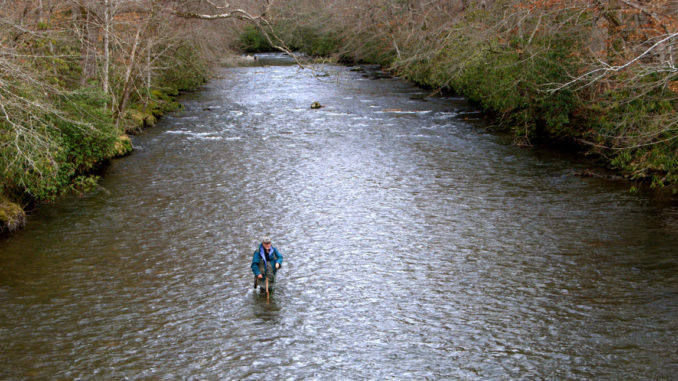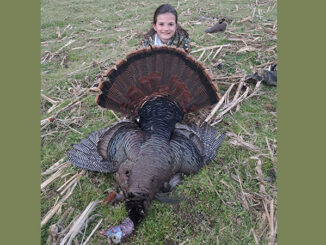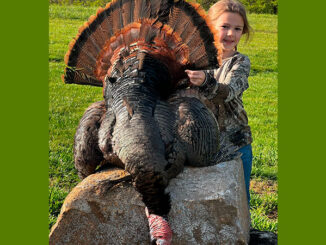
Slow, deep presentations can produce trout
Although spring is undoubtedly the ideal season to fish for mountain trout, winter fishing also has its merits. What most discover is that they catch fewer, but larger, fish. The downside of winter fishing, particularly during the bitter cold of January and February, is that the fishing can test an angler’s mettle and patience.
The key is to use more nymphs and fewer dry flies. Nymph fishing requires more finesse than dry-fly fishing, and strikes are more difficult to detect.
“You have to slow your presentation and concentrate on the slower water in the deeper sections of a pool,” said Roger Lowe of Waynesville, N.C., a guide and life-long fly fisher. “Nymphs will be the best flies to use from now until spring. Dry-fly fishing will be limited to the warmest part of the day when the sun is on the water,” he said. “The numbers may be fewer, but you’ll find a better quality of fish.”
With fewer hatches coming off, nymphs are the type of food that trout, particularly large ones, see and prefer.
Nymphs should be fished close to the bottom of a pool or run and at a slower pace, because everything slows down in the winter, Lowe said. Strikes will be subtle, sometimes little more than a slight hesitation of the line.
One technique that many guides use is to let a nymph dead-drift to the bottom of a pool or run and strip the fly in short spurts. If you see a trout following the fly but not taking it, freeze. If the trout starts to turn away, give the line a jerk. That will make the trout think that the nymph is trying to escape, and it usually will strike.
Lowe said he uses bigger nymphs in the winter, No. 10s, 8s, even 6s.
“I’ll cast a large nymph such as a Woolly Bugger across the current,” he said. “When the line straightens out, I lower the rod tip and work the nymph through the water in short strips. It’s important to keep the rod tip down so that the nymph will stay deep.
“Sometimes, you have to keep casting to the same place to get a strike. Keep your presentation slow to give the trout more time to study the fly.”
Kevin Howell of Davidson River Outfitters near Brevard, N.C., agrees that the most-effective way to fish a nymph is to get the nymph down deep.
“Sometimes,” he said, “you have to put the fly right in the trout’s face to get it to hit.”
Howell uses a weighted nymph instead of a bead-head and bumps it along the bottom of a pool.
“Some anglers add weight to the leader, putting lead about 6 inches above the fly for a yo-yo effect,” Howell said. “I prefer to crimp the weight right on top of the fly. That gets it down to the bottom.”
Winter fishing also can be frustrating because trout will suddenly turn off, and nothing you throw to them will get a strike.
Not all winter fishing is limited to nymphs, however. Warm, sunny winter days can produce small but productive hatches of midges and, periodically, Blue-Winged Olives, which can be found on mountain streams almost any time of the year.
Also, brook trout and brown trout are coming off their fall spawning fasts, and they’re usually hungry and aggressive. The spawning ritual begins as early as mid-September and can continue into November, depending on weather and stream conditions.
During the actual spawn, neither the male nor the female feeds. The male, however, will strike at something he thinks is a threat to the female or her eggs. Once the eggs are laid and covered, the brown’s parental duties are over. The eggs and subsequent fry are on their own. Eggs can survive even if temperatures drop to below zero, as long as the water doesn’t freeze — a rarity for high-gradient southern Appalachian streams.
Once spawning is completed, browns return to their former habitat. For post-spawn brown trout, egg patterns such as Glow Bugs are very effective because brown trout often eat the eggs and young of other trout.
Brook trout follow much the same spawning patterns as brown trout, only later. Since wild brook trout usually are found in small streams, they don’t move as much or as far as browns.
As for catching brooks or browns during the spawn, biologists say angling activity does not adversely affect spawning if a trout is not injured or played to exhaustion when caught.
The best places to find larger brown trout during the spawning cycle are the tributaries of large streams such as the Tuckasegee River, Nantahala River, East Fork of the Pigeon River, South Toe River, and Davidson River. Tributaries that feed lakes also are prime spawning grounds for lake trout. Big browns from Lake Jocassee move up the Thompson River, Whitewater River and Horsepasture River to spawn.
Winter fishing has added appeal because streams are less crowded. Only the hearty get out in cold weather, and the bigger fish are more active.





Be the first to comment